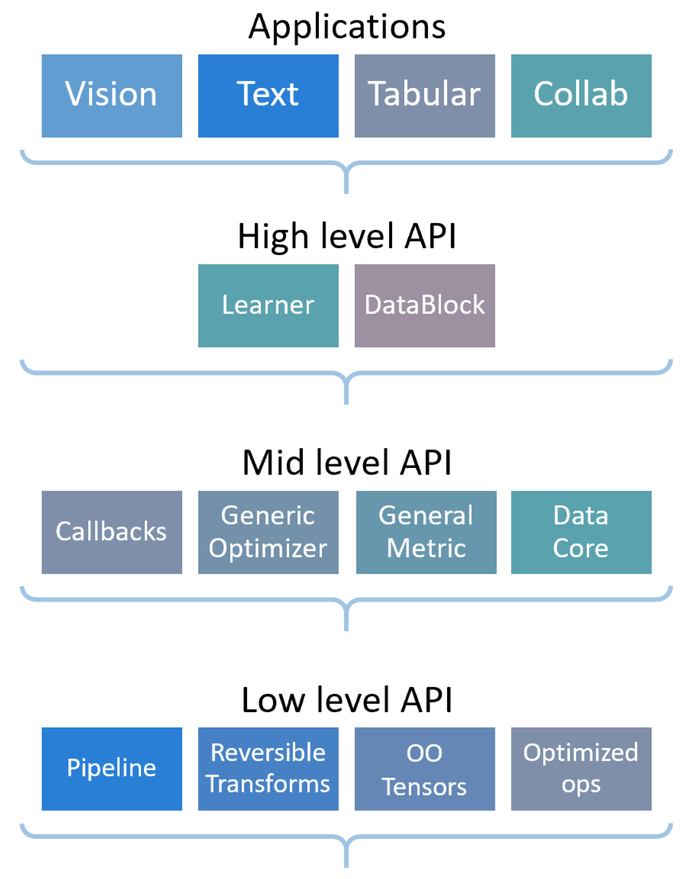
Security News
Fluent Assertions Faces Backlash After Abandoning Open Source Licensing
Fluent Assertions is facing backlash after dropping the Apache license for a commercial model, leaving users blindsided and questioning contributor rights.
fastai simplifies training fast and accurate neural nets using modern best practices
You can use fastai without any installation by using Google Colab. In fact, every page of this documentation is also available as an interactive notebook - click “Open in colab” at the top of any page to open it (be sure to change the Colab runtime to “GPU” to have it run fast!) See the fast.ai documentation on Using Colab for more information.
You can install fastai on your own machines with conda (highly recommended), as long as you’re running Linux or Windows (NB: Mac is not supported). For Windows, please see the “Running on Windows” for important notes.
We recommend using miniconda (or miniforge). First install PyTorch using the conda line shown here, and then run:
conda install -c fastai fastai
To install with pip, use: pip install fastai.
If you plan to develop fastai yourself, or want to be on the cutting edge, you can use an editable install (if you do this, you should also use an editable install of fastcore to go with it.) First install PyTorch, and then:
git clone https://github.com/fastai/fastai
pip install -e "fastai[dev]"
The best way to get started with fastai (and deep learning) is to read the book, and complete the free course.
To see what’s possible with fastai, take a look at the Quick Start, which shows how to use around 5 lines of code to build an image classifier, an image segmentation model, a text sentiment model, a recommendation system, and a tabular model. For each of the applications, the code is much the same.
Read through the Tutorials to learn how to train your own models on your own datasets. Use the navigation sidebar to look through the fastai documentation. Every class, function, and method is documented here.
To learn about the design and motivation of the library, read the peer reviewed paper.
fastai is a deep learning library which provides practitioners with high-level components that can quickly and easily provide state-of-the-art results in standard deep learning domains, and provides researchers with low-level components that can be mixed and matched to build new approaches. It aims to do both things without substantial compromises in ease of use, flexibility, or performance. This is possible thanks to a carefully layered architecture, which expresses common underlying patterns of many deep learning and data processing techniques in terms of decoupled abstractions. These abstractions can be expressed concisely and clearly by leveraging the dynamism of the underlying Python language and the flexibility of the PyTorch library. fastai includes:
fastai is organized around two main design goals: to be approachable and rapidly productive, while also being deeply hackable and configurable. It is built on top of a hierarchy of lower-level APIs which provide composable building blocks. This way, a user wanting to rewrite part of the high-level API or add particular behavior to suit their needs does not have to learn how to use the lowest level.

It’s very easy to migrate from plain PyTorch, Ignite, or any other PyTorch-based library, or even to use fastai in conjunction with other libraries. Generally, you’ll be able to use all your existing data processing code, but will be able to reduce the amount of code you require for training, and more easily take advantage of modern best practices. Here are migration guides from some popular libraries to help you on your way:
Due to python multiprocessing issues on Jupyter and Windows,
num_workers of Dataloader is reset to 0 automatically to avoid
Jupyter hanging. This makes tasks such as computer vision in Jupyter on
Windows many times slower than on Linux. This limitation doesn’t exist
if you use fastai from a script.
See this example to fully leverage the fastai API on Windows.
We recommend using Windows Subsystem for Linux (WSL) instead – if you do
that, you can use the regular Linux installation approach, and you won’t
have any issues with num_workers.
To run the tests in parallel, launch:
nbdev_test
For all the tests to pass, you’ll need to install the dependencies specified as part of dev_requirements in settings.ini
pip install -e .[dev]
Tests are written using nbdev, for example see the documentation for
test_eq.
After you clone this repository, make sure you have run
nbdev_install_hooks in your terminal. This install Jupyter and git
hooks to automatically clean, trust, and fix merge conflicts in
notebooks.
After making changes in the repo, you should run nbdev_prepare and
make additional and necessary changes in order to pass all the tests.
For those interested in official docker containers for this project, they can be found here.
FAQs
fastai simplifies training fast and accurate neural nets using modern best practices
We found that fastai demonstrated a healthy version release cadence and project activity because the last version was released less than a year ago. It has 2 open source maintainers collaborating on the project.
Did you know?

Socket for GitHub automatically highlights issues in each pull request and monitors the health of all your open source dependencies. Discover the contents of your packages and block harmful activity before you install or update your dependencies.

Security News
Fluent Assertions is facing backlash after dropping the Apache license for a commercial model, leaving users blindsided and questioning contributor rights.

Research
Security News
Socket researchers uncover the risks of a malicious Python package targeting Discord developers.

Security News
The UK is proposing a bold ban on ransomware payments by public entities to disrupt cybercrime, protect critical services, and lead global cybersecurity efforts.